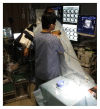Percutaneous Ablation for Hepatocellular Carcinoma: Comparison of Various Ablation Techniques and Surgery
- PMID: 29974040
- PMCID: PMC6008833
- DOI: 10.1155/2018/4756147
Percutaneous Ablation for Hepatocellular Carcinoma: Comparison of Various Ablation Techniques and Surgery
Abstract
Image-guided percutaneous ablation is considered best in the treatment of early-stage hepatocellular carcinoma (HCC). Ablation is potentially curative, minimally invasive, and easily repeatable for recurrence. Ethanol injection used to be the standard in ablation. However, radiofrequency ablation has recently been the most prevailing ablation method for HCC. Many investigators have reported that radiofrequency ablation is superior to ethanol injection, from the viewpoints of treatment response, local tumor curativity, and overall survival. New-generation microwave ablation can create a larger ablation volume in a shorter time period. Further comparison studies are, however, mandatory between radiofrequency ablation and microwave ablation, especially in terms of complications and long-term survival. Irreversible electroporation, which is a non-thermal ablation method that delivers short electric pulses to induce cell death due to apoptosis, requires further studies, especially in terms of long-term outcomes. It is considerably difficult to compare outcomes in ablation with those in surgical resection. However, radiofrequency ablation seems to be a satisfactory alternative to resection for HCC 3 cm or smaller in Child-Pugh class A or B cirrhosis. Furthermore, radiofrequency ablation may be a first-line treatment in HCC 2 cm or smaller in Child-Pugh class A or B cirrhosis. Various innovations would further improve outcomes in ablation. Training programs may be effective in providing an excellent opportunity to understand basic concepts and learn cardinal skills for successful ablation. Sophisticated ablation would be more than an adequate alternative of surgery for small- and possibly middle-sized HCC.
Figures





References
Publication types
MeSH terms
LinkOut - more resources
Full Text Sources
Other Literature Sources
Medical

